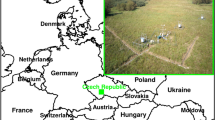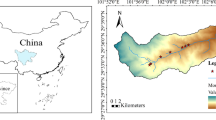Summary
Welwitschia mirabilis is a perennial desert plant with extremely large leaves (0.5–1.0 m broad, 1–2 m long). Leaf temperatures were measured in the field and the energy budget was calculated. The portions of the leaf which were kept above the ground had leaf temperatures which were only 4–6°C above air temperature. In the leaf portions which were in contact with the ground leaf temperatures were 6–12°C above air temperature (absolute maximum 51°C). The important feature in the energy budget ofWelwitschia mirabilis is its high reflectivity (38% of the global radiation). Only about 56% of the global radiation is absorbed by the thick leathery leaves. The energy loss due to convection is of the same order of magnitude as the reflection and it is abouy the same in the portions of leaf on and above the ground. The difference in leaf temperatures found in these portions is due to the loss of thermal radiation from the section of leaf above the ground to the cooler ground which is shaded by the leaf. The provision of a heat sink due to the large area of shade cast by these large leaves is of significance to the existence ofWelwitschia mirabilis in its arid habitats.
Similar content being viewed by others
References
Bornmann, C.H., Elsworthy, J.A., Butler, V., Botha, C.E.J.:Welwitschia mirabilis: Observations on general habitat, seed, seedling, and leaf characteristics. Madoqua1, 53–66 (1972)
Campbell, G.S.: An Introduction to Environmental Biophysics. New York-Berlin-Heidelberg: Springer-Verlag 1977
Eller, B.M.: Messung spektraler Eigenschaften von Blättern im Felde. Verh. Schweiz. Natf. Ges.152, 142–145 (1972)
Eller, B.M.: Die strahlungsökologische Bedeutung von Epidermisauflagen. Flora168, 146–192 (1979)
Gates, D.M.: Leaf temperature and energy exchange. Arch. Meteorol. Geophys. Bioklimatol. [B]12, 321–336 (1963)
Gates, D.M., Keegan, H.N., Schleter, J.C., Weidner, V.R.: Spectral properties of plants. Appl. Opt.4, 11–20 (1965)
Gieß, W.:Welwitschia mirabilis Hook. fil. Dinteria3, 3–56 (1969)
Grisebach, A.: Vegetation der Erde II. Leipzig: Wilhelm Engelmann Verlag 1884
Körner, Ch., Cernusca, A.: A semi-automatic recording diffusion porometer and its performance under alpine field conditions. Photosynthetica10, 172–181 (1976)
Lange, O.L.: Untersuchungen über Wärmehaushalt und Hitzeresistenz mauretanischer Wüsten- und Savannenpflanzen. Flora147, 595–651 (1959)
Lange, O.L., Lange, R.: Untersuchungen über Blattemperaturen, Transpiration und Hitzeresistenz an Pflanzen mediterraner Standorte (Costa brava, Spanien). Flora153, 387–425 (1963)
Monteith, J.L.: Principles of Environmental Physics. London: Edward Arnold (Publishers) Ltd. 1973
Mooney, H.A., Ehleringer, J., Björkman, O.: The energy balance of leaves of the evergreen desert shrubAtriplex hymenelytra. Oecologia (Berl.)29, 301–310 (1977)
Pearman, G.I., Weaver, H.L., Tanner, G.B.: Boundary layer heat transfer coefficients under field conditions. Agric. Meteorol.9, 83–92 (1972)
Raschke, K.: Über die physikalischen Beziehungen zwischen Wärmeübergangszahl, Strahlungsaustausch, Temperatur und Transpiration eines Blattes. Planta48, 200–238 (1956)
Raunkiaer, C.: Life Forms of Plants and Statistical Plant Geography. Oxford: Clarendon Press 1934
Smith, W.K.: Temperatures of desert plants: Another perspective on the adaptability of leaf size. Science201, 614–616 (1978)
Schmithüsen, J.: Allgemeine Vegetationsgeographie. Berlin: Walter de Gruyter and Co 1968
Schulze, E.-D., Schulze, I.: Distribution and control of photosynthetic pathways in plants growing in the Namib desert, with special regard toWelwitschia mirabilis Hook. fil. Madoqua9, 5–13 (1976)
Schulze, E.D., Ziegler, H., Stichler, W.: Environmental control of Crassulacean acid metabolism inWelwitschia mirabilis Hook. fil. in its range of natural distribution in the Namib desert. Oecologia (Berl.)24, 323–334 (1976)
Taylor, S.E.: Optimal leaf form. In: Ecological Studies 12. Perspectives of Biophysical Ecology (D.M. Gates, R.B. Schmerl eds.) Springer Verlag: Berlin-Heidelberg-New York 1975
Volk, O.H.: Die Florengebiete von Südwestafrika. Journal20, S. W. A. Wissensch. Gesellschaft Windhoek, 25–58 (1966)
Willert, v.D.J., Brinckmann, E., Schulze, E.-D.: Ecophysiological investigations in the coastal desert of Southern Africa, pp. 321–331. In: Ecological Processes in Coastal Environments (R.L. Jeffries, A.J. Davy eds.) Oxford Blackwell Scientific Pbs.: 1979
Author information
Authors and Affiliations
Rights and permissions
About this article
Cite this article
Schulze, E.D., Eller, B.M., Thomas, D.A. et al. Leaf temperatures and energy balance ofWelwitschia mirabilis in its natural habitat. Oecologia 44, 258–262 (1980). https://doi.org/10.1007/BF00572688
Received:
Issue Date:
DOI: https://doi.org/10.1007/BF00572688




